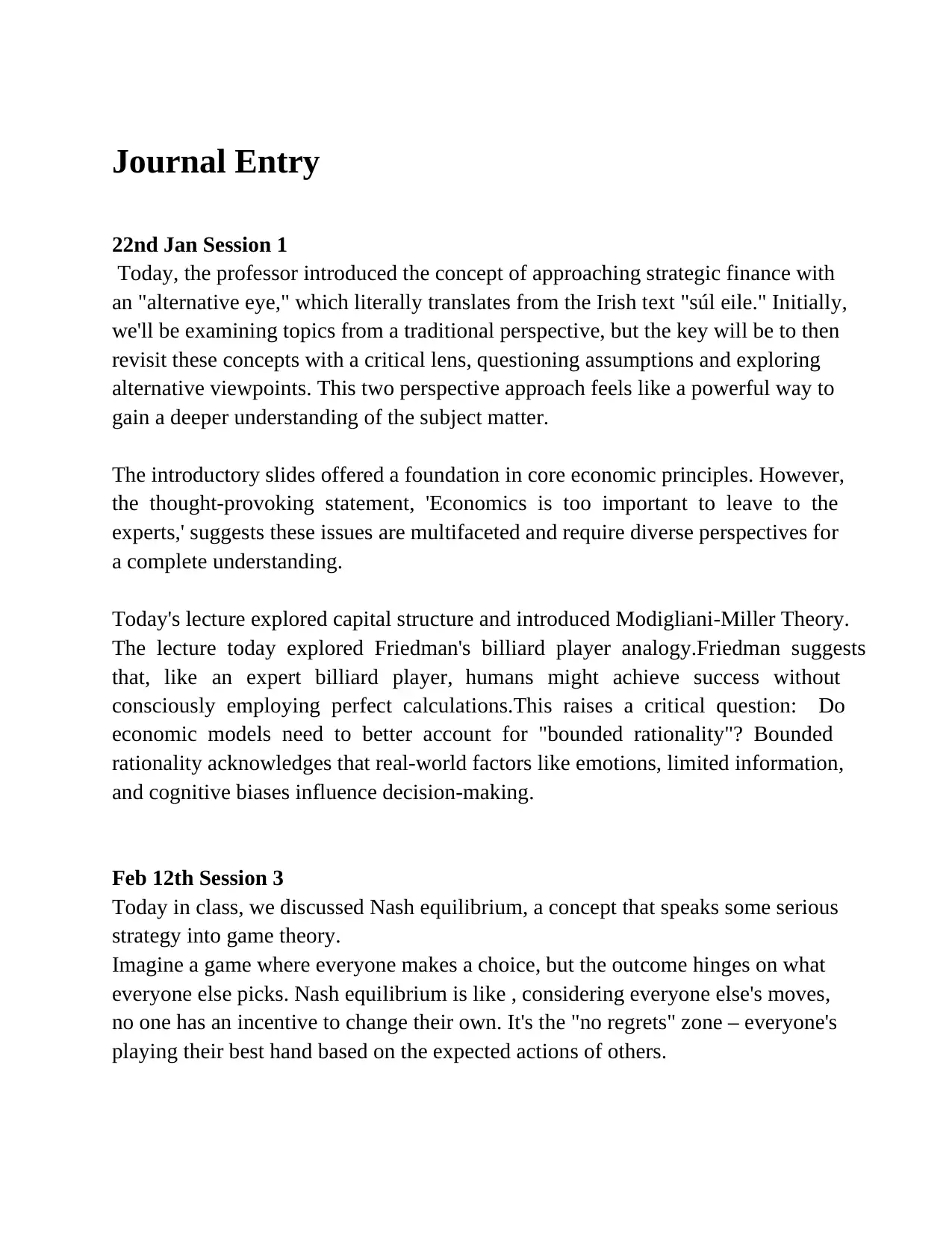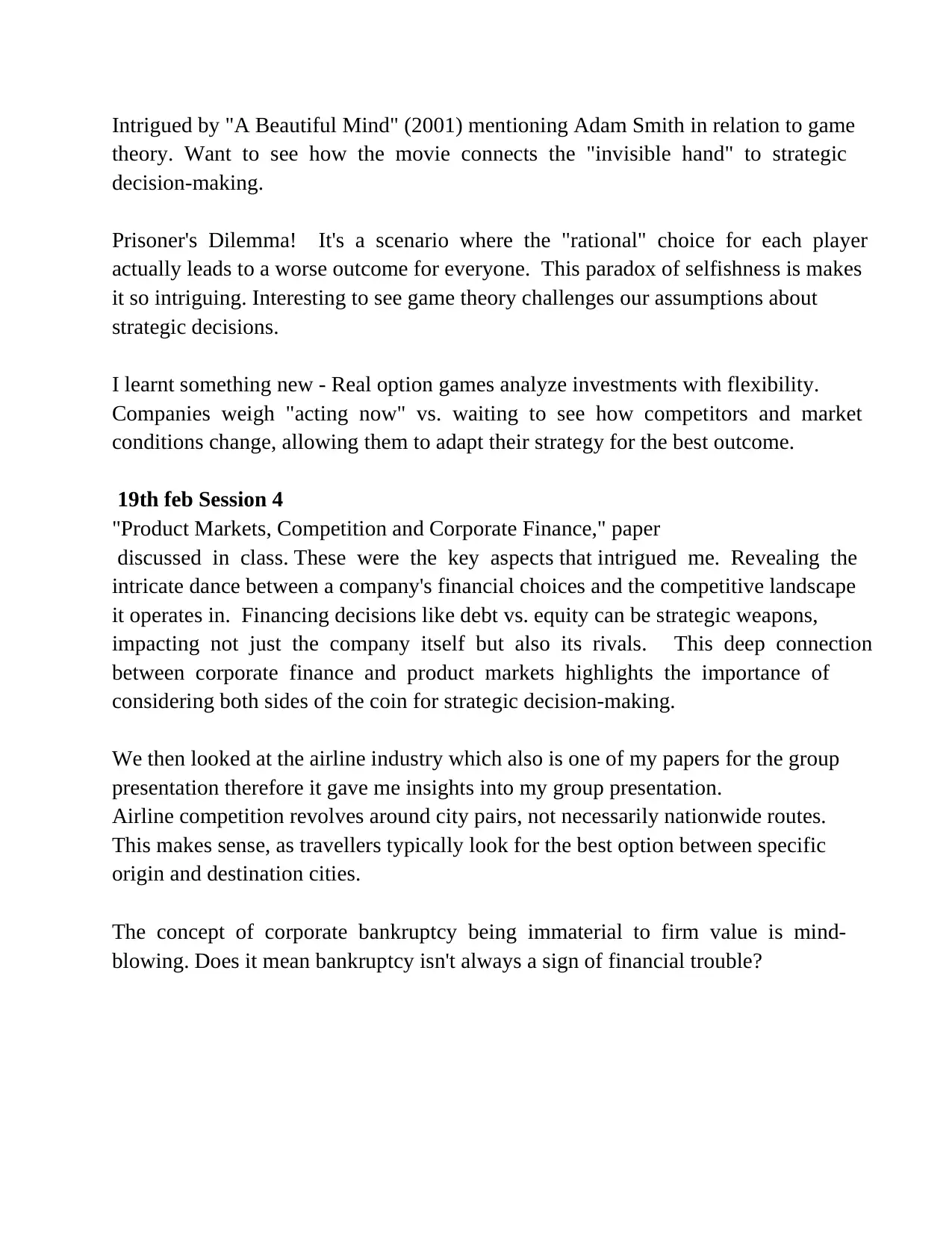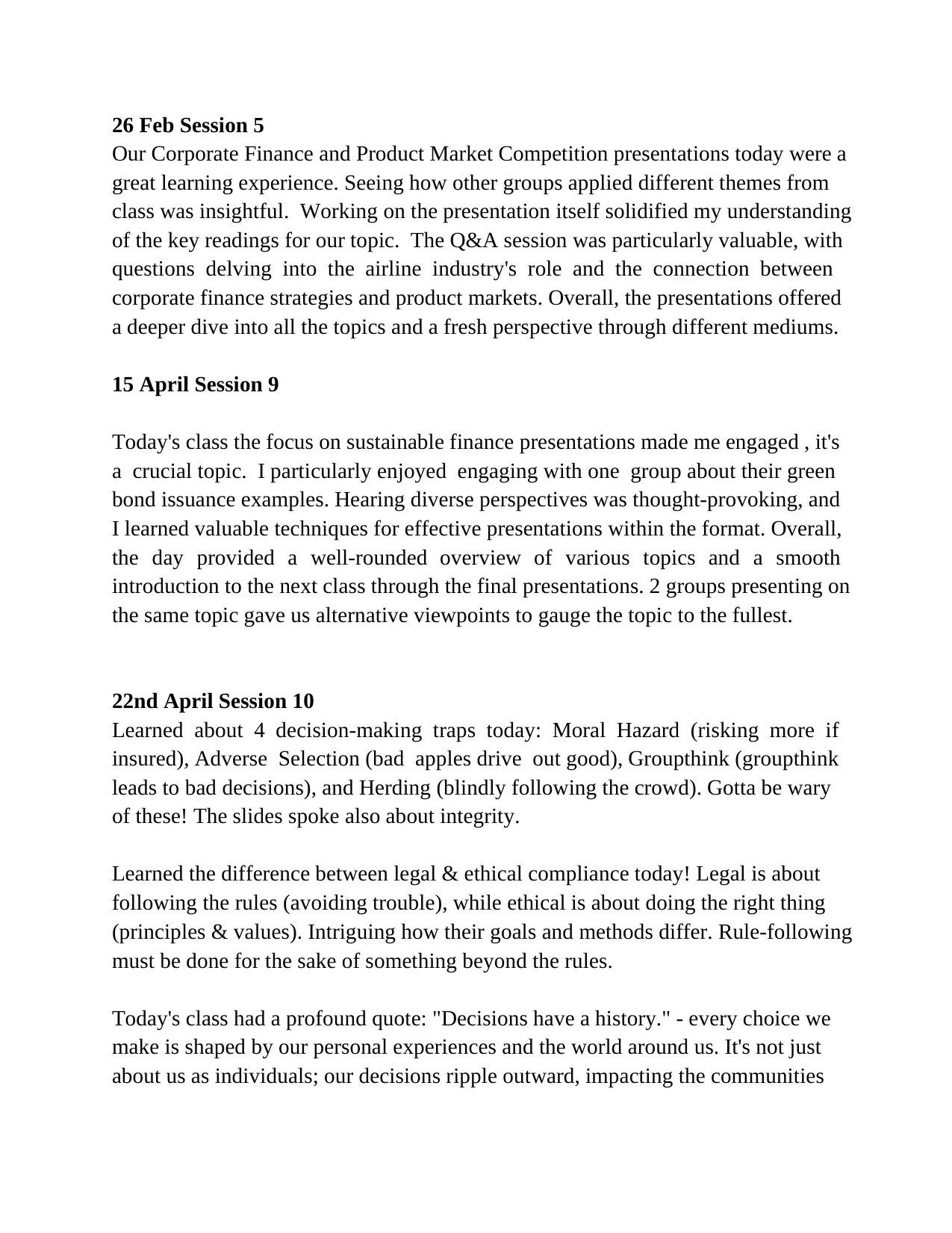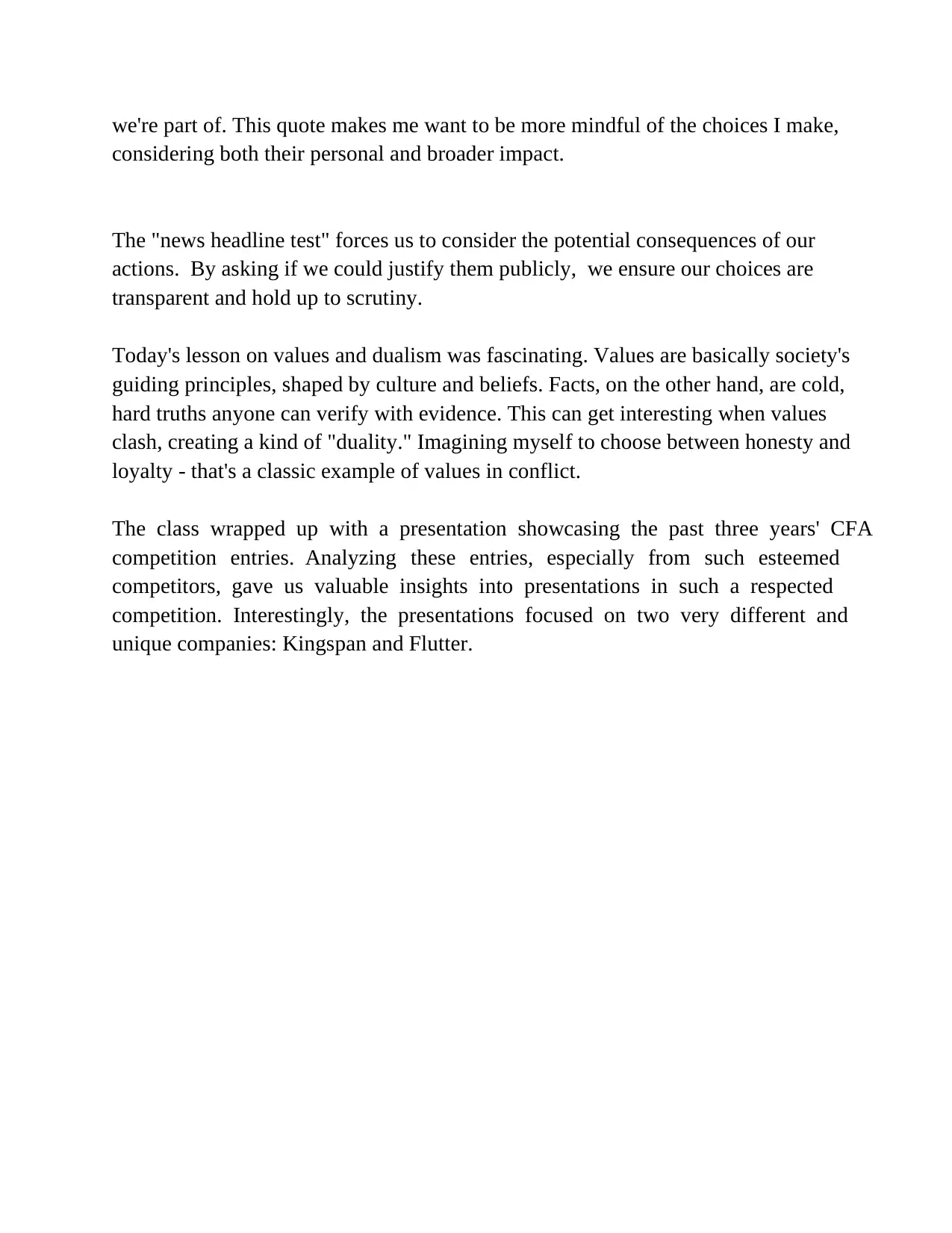Reflective Journal: Strategic Finance, Decision-Making and Ethics
VerifiedAdded on 2024/04/29
|4
|1149
|242
Journal and Reflective Writing
AI Summary
This journal reflects on a Strategic Finance course, beginning with an introduction to approaching topics with a critical, "alternative eye." The entries cover core economic principles, including the Modigliani-Miller Theory and Friedman's billiard player analogy, prompting consideration of bounded rationality in economic models. Game theory concepts like Nash equilibrium and the Prisoner's Dilemma are explored, alongside real option games and the interplay between corporate finance and product markets. Further entries discuss the airline industry, sustainable finance, and decision-making traps such as moral hazard and groupthink. The journal also delves into the importance of integrity, ethical compliance versus legal compliance, and the influence of personal experiences on decision-making. The reflection concludes with an analysis of CFA competition entries, offering insights into effective presentations and diverse company strategies.

Journal Entry
22nd Jan Session 1
Today, the professor introduced the concept of approaching strategic finance with
an "alternative eye," which literally translates from the Irish text "súl eile." Initially,
we'll be examining topics from a traditional perspective, but the key will be to then
revisit these concepts with a critical lens, questioning assumptions and exploring
alternative viewpoints. This two perspective approach feels like a powerful way to
gain a deeper understanding of the subject matter.
The introductory slides offered a foundation in core economic principles. However,
the thought-provoking statement, 'Economics is too important to leave to the
experts,' suggests these issues are multifaceted and require diverse perspectives for
a complete understanding.
Today's lecture explored capital structure and introduced Modigliani-Miller Theory.
The lecture today explored Friedman's billiard player analogy.Friedman suggests
that, like an expert billiard player, humans might achieve success without
consciously employing perfect calculations.This raises a critical question: Do
economic models need to better account for "bounded rationality"? Bounded
rationality acknowledges that real-world factors like emotions, limited information,
and cognitive biases influence decision-making.
Feb 12th Session 3
Today in class, we discussed Nash equilibrium, a concept that speaks some serious
strategy into game theory.
Imagine a game where everyone makes a choice, but the outcome hinges on what
everyone else picks. Nash equilibrium is like , considering everyone else's moves,
no one has an incentive to change their own. It's the "no regrets" zone – everyone's
playing their best hand based on the expected actions of others.
22nd Jan Session 1
Today, the professor introduced the concept of approaching strategic finance with
an "alternative eye," which literally translates from the Irish text "súl eile." Initially,
we'll be examining topics from a traditional perspective, but the key will be to then
revisit these concepts with a critical lens, questioning assumptions and exploring
alternative viewpoints. This two perspective approach feels like a powerful way to
gain a deeper understanding of the subject matter.
The introductory slides offered a foundation in core economic principles. However,
the thought-provoking statement, 'Economics is too important to leave to the
experts,' suggests these issues are multifaceted and require diverse perspectives for
a complete understanding.
Today's lecture explored capital structure and introduced Modigliani-Miller Theory.
The lecture today explored Friedman's billiard player analogy.Friedman suggests
that, like an expert billiard player, humans might achieve success without
consciously employing perfect calculations.This raises a critical question: Do
economic models need to better account for "bounded rationality"? Bounded
rationality acknowledges that real-world factors like emotions, limited information,
and cognitive biases influence decision-making.
Feb 12th Session 3
Today in class, we discussed Nash equilibrium, a concept that speaks some serious
strategy into game theory.
Imagine a game where everyone makes a choice, but the outcome hinges on what
everyone else picks. Nash equilibrium is like , considering everyone else's moves,
no one has an incentive to change their own. It's the "no regrets" zone – everyone's
playing their best hand based on the expected actions of others.
Paraphrase This Document
Need a fresh take? Get an instant paraphrase of this document with our AI Paraphraser

Intrigued by "A Beautiful Mind" (2001) mentioning Adam Smith in relation to game
theory. Want to see how the movie connects the "invisible hand" to strategic
decision-making.
Prisoner's Dilemma! It's a scenario where the "rational" choice for each player
actually leads to a worse outcome for everyone. This paradox of selfishness is makes
it so intriguing. Interesting to see game theory challenges our assumptions about
strategic decisions.
I learnt something new - Real option games analyze investments with flexibility.
Companies weigh "acting now" vs. waiting to see how competitors and market
conditions change, allowing them to adapt their strategy for the best outcome.
19th feb Session 4
"Product Markets, Competition and Corporate Finance," paper
discussed in class. These were the key aspects that intrigued me. Revealing the
intricate dance between a company's financial choices and the competitive landscape
it operates in. Financing decisions like debt vs. equity can be strategic weapons,
impacting not just the company itself but also its rivals. This deep connection
between corporate finance and product markets highlights the importance of
considering both sides of the coin for strategic decision-making.
We then looked at the airline industry which also is one of my papers for the group
presentation therefore it gave me insights into my group presentation.
Airline competition revolves around city pairs, not necessarily nationwide routes.
This makes sense, as travellers typically look for the best option between specific
origin and destination cities.
The concept of corporate bankruptcy being immaterial to firm value is mind-
blowing. Does it mean bankruptcy isn't always a sign of financial trouble?
theory. Want to see how the movie connects the "invisible hand" to strategic
decision-making.
Prisoner's Dilemma! It's a scenario where the "rational" choice for each player
actually leads to a worse outcome for everyone. This paradox of selfishness is makes
it so intriguing. Interesting to see game theory challenges our assumptions about
strategic decisions.
I learnt something new - Real option games analyze investments with flexibility.
Companies weigh "acting now" vs. waiting to see how competitors and market
conditions change, allowing them to adapt their strategy for the best outcome.
19th feb Session 4
"Product Markets, Competition and Corporate Finance," paper
discussed in class. These were the key aspects that intrigued me. Revealing the
intricate dance between a company's financial choices and the competitive landscape
it operates in. Financing decisions like debt vs. equity can be strategic weapons,
impacting not just the company itself but also its rivals. This deep connection
between corporate finance and product markets highlights the importance of
considering both sides of the coin for strategic decision-making.
We then looked at the airline industry which also is one of my papers for the group
presentation therefore it gave me insights into my group presentation.
Airline competition revolves around city pairs, not necessarily nationwide routes.
This makes sense, as travellers typically look for the best option between specific
origin and destination cities.
The concept of corporate bankruptcy being immaterial to firm value is mind-
blowing. Does it mean bankruptcy isn't always a sign of financial trouble?

26 Feb Session 5
Our Corporate Finance and Product Market Competition presentations today were a
great learning experience. Seeing how other groups applied different themes from
class was insightful. Working on the presentation itself solidified my understanding
of the key readings for our topic. The Q&A session was particularly valuable, with
questions delving into the airline industry's role and the connection between
corporate finance strategies and product markets. Overall, the presentations offered
a deeper dive into all the topics and a fresh perspective through different mediums.
15 April Session 9
Today's class the focus on sustainable finance presentations made me engaged , it's
a crucial topic. I particularly enjoyed engaging with one group about their green
bond issuance examples. Hearing diverse perspectives was thought-provoking, and
I learned valuable techniques for effective presentations within the format. Overall,
the day provided a well-rounded overview of various topics and a smooth
introduction to the next class through the final presentations. 2 groups presenting on
the same topic gave us alternative viewpoints to gauge the topic to the fullest.
22nd April Session 10
Learned about 4 decision-making traps today: Moral Hazard (risking more if
insured), Adverse Selection (bad apples drive out good), Groupthink (groupthink
leads to bad decisions), and Herding (blindly following the crowd). Gotta be wary
of these! The slides spoke also about integrity.
Learned the difference between legal & ethical compliance today! Legal is about
following the rules (avoiding trouble), while ethical is about doing the right thing
(principles & values). Intriguing how their goals and methods differ. Rule-following
must be done for the sake of something beyond the rules.
Today's class had a profound quote: "Decisions have a history." - every choice we
make is shaped by our personal experiences and the world around us. It's not just
about us as individuals; our decisions ripple outward, impacting the communities
Our Corporate Finance and Product Market Competition presentations today were a
great learning experience. Seeing how other groups applied different themes from
class was insightful. Working on the presentation itself solidified my understanding
of the key readings for our topic. The Q&A session was particularly valuable, with
questions delving into the airline industry's role and the connection between
corporate finance strategies and product markets. Overall, the presentations offered
a deeper dive into all the topics and a fresh perspective through different mediums.
15 April Session 9
Today's class the focus on sustainable finance presentations made me engaged , it's
a crucial topic. I particularly enjoyed engaging with one group about their green
bond issuance examples. Hearing diverse perspectives was thought-provoking, and
I learned valuable techniques for effective presentations within the format. Overall,
the day provided a well-rounded overview of various topics and a smooth
introduction to the next class through the final presentations. 2 groups presenting on
the same topic gave us alternative viewpoints to gauge the topic to the fullest.
22nd April Session 10
Learned about 4 decision-making traps today: Moral Hazard (risking more if
insured), Adverse Selection (bad apples drive out good), Groupthink (groupthink
leads to bad decisions), and Herding (blindly following the crowd). Gotta be wary
of these! The slides spoke also about integrity.
Learned the difference between legal & ethical compliance today! Legal is about
following the rules (avoiding trouble), while ethical is about doing the right thing
(principles & values). Intriguing how their goals and methods differ. Rule-following
must be done for the sake of something beyond the rules.
Today's class had a profound quote: "Decisions have a history." - every choice we
make is shaped by our personal experiences and the world around us. It's not just
about us as individuals; our decisions ripple outward, impacting the communities
⊘ This is a preview!⊘
Do you want full access?
Subscribe today to unlock all pages.

Trusted by 1+ million students worldwide

we're part of. This quote makes me want to be more mindful of the choices I make,
considering both their personal and broader impact.
The "news headline test" forces us to consider the potential consequences of our
actions. By asking if we could justify them publicly, we ensure our choices are
transparent and hold up to scrutiny.
Today's lesson on values and dualism was fascinating. Values are basically society's
guiding principles, shaped by culture and beliefs. Facts, on the other hand, are cold,
hard truths anyone can verify with evidence. This can get interesting when values
clash, creating a kind of "duality." Imagining myself to choose between honesty and
loyalty - that's a classic example of values in conflict.
The class wrapped up with a presentation showcasing the past three years' CFA
competition entries. Analyzing these entries, especially from such esteemed
competitors, gave us valuable insights into presentations in such a respected
competition. Interestingly, the presentations focused on two very different and
unique companies: Kingspan and Flutter.
considering both their personal and broader impact.
The "news headline test" forces us to consider the potential consequences of our
actions. By asking if we could justify them publicly, we ensure our choices are
transparent and hold up to scrutiny.
Today's lesson on values and dualism was fascinating. Values are basically society's
guiding principles, shaped by culture and beliefs. Facts, on the other hand, are cold,
hard truths anyone can verify with evidence. This can get interesting when values
clash, creating a kind of "duality." Imagining myself to choose between honesty and
loyalty - that's a classic example of values in conflict.
The class wrapped up with a presentation showcasing the past three years' CFA
competition entries. Analyzing these entries, especially from such esteemed
competitors, gave us valuable insights into presentations in such a respected
competition. Interestingly, the presentations focused on two very different and
unique companies: Kingspan and Flutter.
1 out of 4
Your All-in-One AI-Powered Toolkit for Academic Success.
+13062052269
info@desklib.com
Available 24*7 on WhatsApp / Email
![[object Object]](/_next/static/media/star-bottom.7253800d.svg)
Unlock your academic potential
Copyright © 2020–2025 A2Z Services. All Rights Reserved. Developed and managed by ZUCOL.